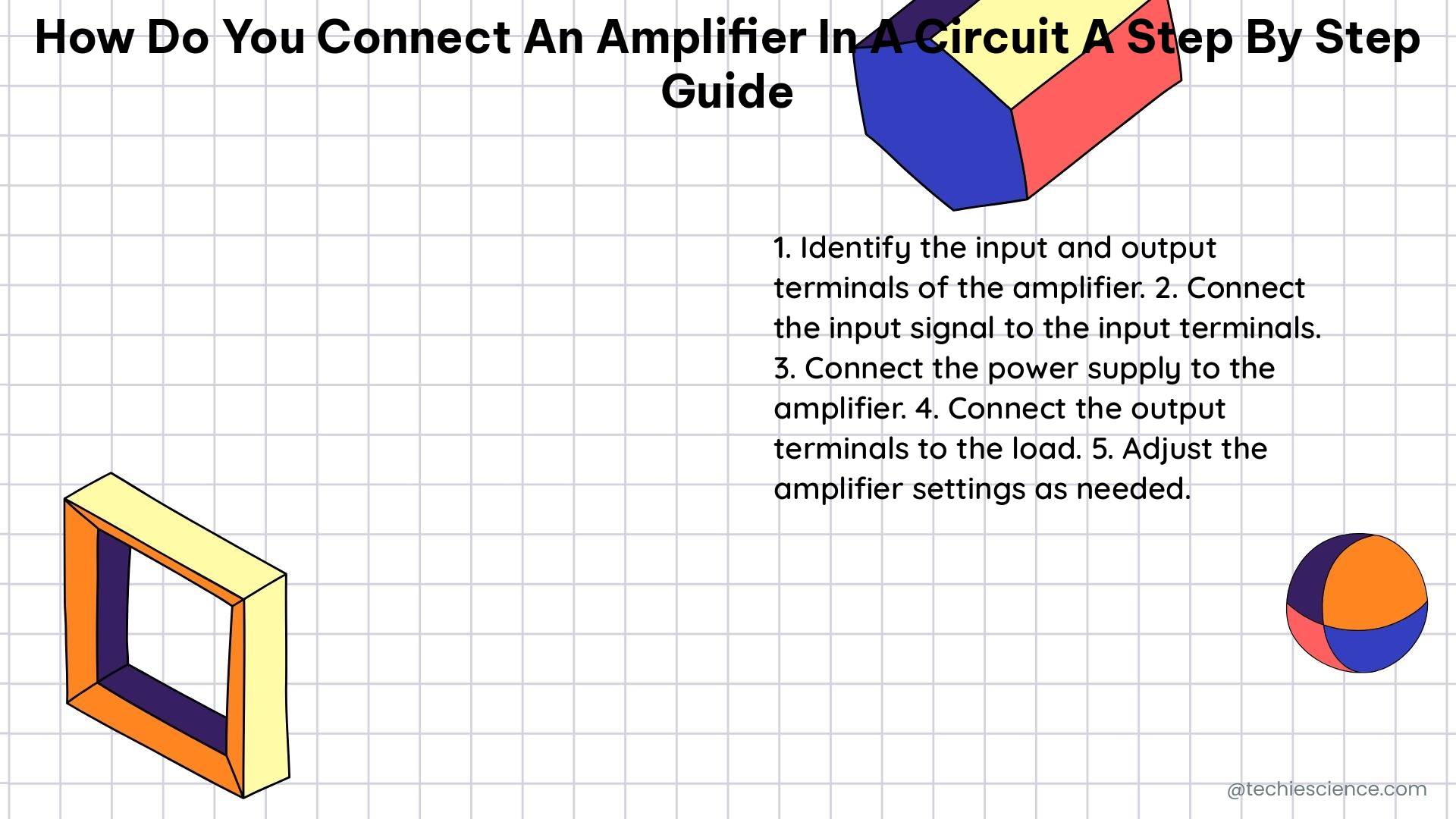Connecting an amplifier in a circuit is a crucial step in various electronic projects, from audio systems to industrial applications. This comprehensive guide will walk you through the process of connecting an amplifier in a circuit, providing detailed instructions and measurable data to ensure a successful setup.
Step 1: Choose the Right Amplifier
The first step in connecting an amplifier is to select the appropriate one for your specific application. When choosing an amplifier, consider the following key specifications:
Power Rating
The power rating of an amplifier is measured in watts (W) and determines the maximum output power the amplifier can deliver. This is an essential factor to consider, as the power rating should match the power requirements of the connected components, such as speakers or other load devices.
For example, if you’re connecting the amplifier to a pair of 100W speakers, you’ll need an amplifier with a power rating of at least 100W per channel to ensure proper operation and avoid overloading the speakers.
Impedance
Impedance, measured in ohms (Ω), is the resistance of the circuit that the amplifier is connected to. Matching the impedance of the amplifier to the impedance of the connected components is crucial to ensure efficient power transfer and prevent signal distortion.
Typical impedance values for amplifiers and speakers range from 4Ω to 16Ω. It’s essential to select an amplifier with an impedance rating that matches the impedance of the connected components.
Gain
Gain, measured in decibels (dB), is the amplification factor of the amplifier. It determines how much the input signal is amplified before being sent to the output. The gain setting should be adjusted to provide the desired level of amplification without introducing excessive distortion.
Step 2: Connect the Power Supply

Once you’ve selected the appropriate amplifier, the next step is to connect the power supply. The power supply should provide the correct voltage and current to the amplifier, as specified in the amplifier’s technical specifications.
Voltage
The voltage supplied to the amplifier must match the amplifier’s voltage requirements, which are typically in the range of 12V to 48V for most consumer and professional audio amplifiers. Connecting the amplifier to an incorrect voltage can damage the device.
Current
The current supplied to the amplifier must be sufficient to handle the amplifier’s power requirements. The current draw of the amplifier can be calculated using the formula:
Current (A) = Power (W) / Voltage (V)
For example, if an amplifier has a power rating of 100W and operates at 24V, the required current would be:
Current (A) = 100W / 24V = 4.17A
It’s essential to use a power supply that can deliver the required current without overheating or causing voltage drops.
Step 3: Connect the Input Signal
The next step is to connect the input signal to the amplifier. This involves considering the following specifications:
Impedance
The input impedance of the amplifier, measured in ohms (Ω), should match the impedance of the source device (e.g., a preamplifier, mixer, or audio player) to ensure efficient signal transfer and minimize signal loss.
Signal Level
The input signal level, measured in volts (V), should be within the amplifier’s input voltage range to avoid clipping or distortion. If the input signal level is too low, the amplifier may not provide sufficient gain, while a signal that is too high can cause the amplifier to clip and introduce distortion.
Step 4: Connect the Output
After connecting the input signal, the next step is to connect the output of the amplifier to the load device, such as speakers or other audio equipment.
Impedance
The output impedance of the amplifier, measured in ohms (Ω), should match the impedance of the connected load device to ensure efficient power transfer and prevent signal reflections.
Power Rating
The power rating of the connected load device, measured in watts (W), should be equal to or greater than the output power of the amplifier to prevent overloading and potential damage to the components.
Step 5: Ground the Amplifier
Proper grounding of the amplifier is essential to ensure safe and reliable operation. The ground connection should have a low impedance and be able to handle the current requirements of the amplifier.
Ground Resistance
The ground resistance, measured in ohms (Ω), should be as low as possible to provide a stable and reliable ground reference for the amplifier. A ground resistance of less than 1Ω is generally recommended for optimal performance.
Step 6: Test the Circuit
After connecting all the components, it’s essential to test the circuit to ensure proper operation and identify any potential issues.
Voltage Measurements
Measure the input voltage, output voltage, and any other relevant voltages in the circuit to ensure they are within the specified ranges for the amplifier and connected components.
Current Measurements
Measure the input current and output current to ensure they are within the amplifier’s and connected components’ specifications.
Power Measurements
Calculate the power consumption of the amplifier and connected components to ensure they are within the system’s overall power budget.
By following these steps and considering the measurable and quantifiable data, you can ensure that the amplifier is connected correctly in the circuit, optimizing its performance and preventing potential issues.
References

The lambdageeks.com Core SME Team is a group of experienced subject matter experts from diverse scientific and technical fields including Physics, Chemistry, Technology,Electronics & Electrical Engineering, Automotive, Mechanical Engineering. Our team collaborates to create high-quality, well-researched articles on a wide range of science and technology topics for the lambdageeks.com website.
All Our Senior SME are having more than 7 Years of experience in the respective fields . They are either Working Industry Professionals or assocaited With different Universities. Refer Our Authors Page to get to know About our Core SMEs.